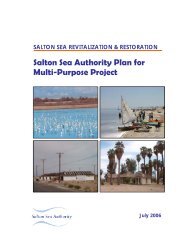Salton Sea Preliminary In-Sea Geotechnical Investigation
Salton Sea Preliminary In-Sea Geotechnical Investigation
Salton Sea Preliminary In-Sea Geotechnical Investigation
Create successful ePaper yourself
Turn your PDF publications into a flip-book with our unique Google optimized e-Paper software.
SECTIONONE<strong>In</strong>troductionSECTION 1INTRODUCTIONThis report presents the results of URS Corporation’s (URS) preliminary geotechnical investigation tosupport selection of a preferred alternative for restoration of the <strong>Salton</strong> <strong>Sea</strong> (<strong>Sea</strong>). The <strong>Sea</strong> is located inRiverside and Imperial Counties in southern California, south of <strong>In</strong>dio and north of El Centro. Thevicinity of the <strong>Sea</strong> is shown in Figure 1. The <strong>Sea</strong> is situated in a closed basin, more than 200 feet belowsea (ocean) level, and has no natural outlet. The primary objective of the restoration alternative will to becontrol the salinity and elevation of the <strong>Sea</strong>.This report presents results of the field explorations and laboratory testing that have been performed aspart of the investigation. It also presents geotechnical considerations for conceptual development ofrestoration alternatives, and recommendations for additional studies that should be undertaken. Thisreport has been prepared for Tetra Tech, <strong>In</strong>c. and the <strong>Salton</strong> <strong>Sea</strong> Authority (SSA) for use in developmentof restoration alternatives.1.1 BACKGROUND OF RESTORATION PROJECTThe current <strong>Sea</strong> was formed between 1905 and 1907 when an irrigation control structure on the ColoradoRiver (in Mexico) was breached, allowing the entire river to flow into the <strong>Salton</strong> Basin for a period of 18months. Since that time, agricultural drainage flows from the Imperial, Coachella, and Mexicali Valleyshas sustained the <strong>Sea</strong>. Recent annual inflows have been in balance with the evaporative losses from the<strong>Sea</strong>, resulting in a fairly stable <strong>Sea</strong> elevation. However, seasonal fluctuations have contributed toalternately flooding and stranding of facilities along the shoreline. Currently, the <strong>Sea</strong> is about 35 mileslong and 15 miles wide with a surface elevation of about –227 feet Mean <strong>Sea</strong> Level (MSL).The inflows contribute four to five million tons of salt each year to the <strong>Sea</strong>. Since the <strong>Sea</strong> is a terminalbody of water, the salinity of the <strong>Sea</strong> has continued to rise since it was flooded. Currently, the salinity ofthe <strong>Sea</strong> is about 44,000 milligrams per liter (mg/L); about 25% saltier than the ocean. Water quality issuesare compounded by eutrophic (nutrient-rich) conditions that stimulate the growth in aquatic life, oftenresulting in the reduction of dissolved oxygen.The <strong>Sea</strong> is a productive sport fishery and provides important migratory and resident bird habitat withinthe Pacific Flyway. The increasing salinity and eutrophic conditions will threaten these habitats. <strong>In</strong>addition, the fluctuations in the sea level and the deteriorating water quality have limited the potential foreconomic and recreational development at the <strong>Sea</strong>. To improve the environmental conditions, andpromote recreational and economic development, various studies have been undertaken to evaluaterestoration alternatives for the <strong>Sea</strong>.An early investigative report was prepared in 1965, a Federal-State Reconnaissance <strong>In</strong>vestigation wasconducted in 1969, and a Federal-State Feasibility Study was completed in 1974 (USBR, 1974).However, a rising water surface elevation, and the consequential stabilization of salinity levels, delayedthe need for salinity control measures at that time.Further studies on the deterioration of the water quality of the <strong>Sea</strong> were initiated in the mid-1990s. Areport was issued in 1998 that outlined conceptual designs for various restoration alternatives (USBR,1998). A draft EIS/EIR was issued (Tetra Tech, 2000) that considered the environmental impacts ofW:\27663042\00005-c-r.doc\1-Mar-04\SDG 1-1



